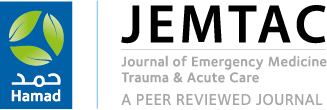- Home
- A-Z Publications
- Journal of Emergency Medicine, Trauma and Acute Care
- Previous Issues
- Volume 2014, Issue 1
Journal of Emergency Medicine, Trauma and Acute Care - Volume 2014, Issue 1
Volume 2014, Issue 1
-
Lightning injury in a desert
More LessAuthors: Nissar Shaikh, Firdous Ummunnisa, Muneer Mahomed and Noora el-TamimiThunderstorms and lightning are uncommon in the Arabian Gulf. Lightning is a giant spark of electricity in the atmosphere or between atmosphere and ground. Most frequently fatalities after the lightning injury are due to direct lightning strike and cardiorespiratory arrest. It is essential that acute care physicians as well as paramedical personnel are aware of lightning injury and its management. This is a case of a field worker who was struck Read More
-
ASL/ALT ratio as a triage marker for enteric fever in the emergency department
More LessObjective: Early differentiation of enteric (typhoid) fever from other febrile conditions has been difficult due to the non-specific clinical presentations and lack of substantiating laboratory clues. Transaminase alterations in enteric fever were thought to be non-specific and have not been investigated before in comparison with other febrile conditions with regards to their prevalence and the aspartate amino transferase/alanine amino transferase ( Read More
-
Management of benign paroxysmal positional vertigo (BPPV) in the emergency department
More LessAuthors: Khalid Bashir, Furqan Irfan and Peter A CameronBenign paroxysmal positional vertigo (BPPV) is a common medical condition that can be managed by emergency physicians. Vertigo sufferers usually complain of the room spinning associated with certain head movements such as getting out of bed, looking up and bending down. BPPV can be diagnosed clinically from history and examination and does not require any investigations. BPPV can be effectively treated at the bedside by Read More
-
Critique of “Identifying the bleeding trauma patient: predictive factors for massive transfusion in an Australasian trauma population”
More LessBackground: Military and civilian data would suggest that hemostatic resuscitation results in improved outcomes for exsanguinating patients. However, identification of those patients who are at risk of significant hemorrhage is not clearly defined. We attempted to identify factors that would predict the need for massive transfusion (MT) in an Australasian trauma population, by comparing those trauma patients who did receive massive transf Read More
-
Monitoring the treatment of myocardial stunning syndrome after acute carbon monoxide poisoning using arterial pulse wave analysis: a case report
More LessAuthors: Vasiliki Soulountsi, Athina Lavrentieva, Vasiliki Karali, Chrysa Nakou and Militsa BitzaniMyocardial injury due to acute carbon monoxide intoxication is often refractory to standard resuscitation methods. Levosimendan is a new inotropic agent that is used in the treatment of acute and chronic heart failure. We report a case of severe cardiopulmonary compromise after exposure to carbon monoxide in a 40-year-old woman who was monitored using transthoracic echocardiography and the arterial pulse contour analysis s Read More
-
Acute mastoiditis in children in the State of Qatar
More LessAuthors: Shihab Mohammed Albaraznji, Khalid Al Ansari and Mayed Mohamed RadiBackground: Acute mastoiditis is a serious complication of otitis media. Its diagnosis and treatment carry a great importance due to its potentially serious consequences. This study was designed to evaluate recent clinical experiences with pediatric acute mastoiditis in the State of Qatar. Our objectives were to highlight the importance of this disease and its possible complications, which emphasize the necessity of early diagnosis a Read More
Most Read This Month
Article
content/journals/jemtac
Journal
10
5
true
en


